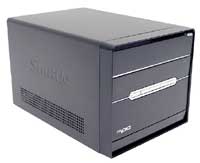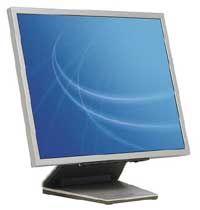Mid-Range SFF Gaming System
One area that we didn't address yet is the potential to go with a small form factor (SFF) system. This especially makes sense for those who attend LAN parties, not to mention the college students that lack space for a large system in their dorm rooms. Many people think that SFF systems are really expensive, but that's not necessarily true. All told, the cost of going with a SFF setup is about $50 more than going with a standard desktop system. There are drawbacks, but first, let's list our SFF configuration, again using an Athlon 64.
| Mid-Range SFF AMD Athlon 64 System |
| Hardware |
Recommended Component |
Price |
| Processor |
AMD Athlon 64 3500+ 512K 2.2 GHz (939) 90nm |
285 |
| Memory |
Mushkin Dual Pack 2x512 PC3200 2.5-3-3 |
159 |
| Video Card |
Albatron GeFORCE 6800 GT 256MB GDDR3 |
374 |
| Hard Drive |
Seagate 160GB SATA 7200RPM 8MB Model ST3160023AS |
93 |
| Optical Drive |
NEC DVD+/-RW Drive Model 3500A |
72 |
| SFF Case |
Shuttle XPC SN95G5 (AMD socket 939) |
299 |
| Display |
Samsung 172X 17 LCD |
429 |
| Speakers |
Logitech Z-640 5.1 |
52 |
| Keyboard |
Logitech Internet Keyboard |
17 |
| Mouse |
Microsoft IntelliMouse Optical |
24 |
| Bottom Line |
|
1804 |

Click to enlarge. |
The total price of our SFF configuration ends up being almost $300 more than the Mid-Range system, but there are reasons for this. We have included a 17" LCD with our SFF recommendation, which is the lion's share of the price increase. After all, what's the point of getting a space-saving, portable case if you're going to pair it with a bulky CRT? That adds an extra $200 to the price, so if you disagree and feel that CRTs and SFFs can peacefully coexist, you can put together a Mid-Range SFF system for $1600. As with the high-end setup, we strongly recommend that anyone looking for a quality LCD get a model that had a DVI-D interface. Unfortunately, one knock against the Samsung 172X is that it is an 18-bit display, which uses dithering/interpolation to "reproduce" 24-bit color. This doesn't matter too much in games, and the 12 ms response time convinces us to go with it anyway, but we're not entirely happy with the options in the 17" LCD segment. Besides the display, remember that a SFF case includes the motherboard and a custom heatsink for the CPU in addition to the case and power supply. So, the $300 cost of the Shuttle XPC takes the place of about $225 of desktop hardware - $250 if you want an aftermarket HSF for your system.

Click to enlarge. |
The one thing that you do sacrifice with a SFF is expansion options. Where most desktop cases can support three or four 5.25" drives, two external 3.5" bays, and three or more internal 3.5" hard drives, the Shuttle XPC that we have used is limited to one 5.25" drive and one 3.5" drive externally, along with one 3.5" internal mount for your hard drive. It is also limited to one AGP slot and one PCI slot, but with all of the included features, the lack of PCI slots is not likely to be an issue. RAM expansion options have been cut back to two DIMM sockets, so even with 1 GB DIMMs, you would max out at 2 GB of RAM. None of these issues are deal-breakers, however, and when paired with a 6800 or X800 graphics card, you have a lot of performance packed into a small, quiet chassis.
We have only included a SFF recommendation for a socket 939 Athlon system, but you could do the same with any other platform. Nearly every motherboard manufacturer has at least one SFF system available, and usually they have several. If you don't upgrade components frequently, SFF cases can be a convenient replacement of the standard "boring" home or office computer.












70 Comments
View All Comments
nghtdvl - Monday, November 22, 2004 - link
Good guide, thanks.I'm still waiting to see some NF4 boards before getting a new system, though. I'm hoping the Gigabyte GA-K8NXP-939 will perform well.
Glassmaster - Monday, November 22, 2004 - link
#7: The Gigabyte board isn't worth the trouble, if you really want an nForce 3 get the MSI K8N Neo2. There's a good reason why Anandtech isn't recommending the Gigabyte board.Jarred: Do you guys actually build and stress test these systems? Over at the offical AMD Athlon 64 troubleshooting forums, the most common problem we see is weak power supplys without enough amps on the 12V rail causing stability issues or even failing to POST. We generally recommend only PSUs with at least 18-20A on the 12V rail for the Athlon 64. I tried to look up the specs on that generic 350W PSU, but was unable to find them. Even the 350W Antec is difficult to find specs for. I know you are trying to save money, but what about the Antec True Power 380W (18A on 12V rail) for low end, and Antec True Power 430W (26A on the 12V rail) for the mid-range?
Glassmaster.
Brian23 - Monday, November 22, 2004 - link
I like the fact that the guide reminds people that the price of SLI is too high for anyone but the most hardcore gamer.crazycarl - Monday, November 22, 2004 - link
i like the new format for the buyer's guides!bsrealm - Monday, November 22, 2004 - link
great guide, but i see there is no mention about RAIDing the SATA drives.. wouldnt that improve performance (atleast while installing and reading the game files)i am also a graphic designer and i guess while loading large files RAID would help..
and i agree with drpepper - video editors' guide please!!!
xsilver - Monday, November 22, 2004 - link
thanks jarred -- im just laughing to see the same situation as pci video cards -- I still see tnt2 pci go for $50 on ebay! -- what a joke.... I don't want to be one of those stuck with something that is going to cost more in the long run :)drpepper1280 - Sunday, November 21, 2004 - link
Thank you,This was the way buyers guiders were meant to be done. Now for one on video editing!
ariafrost - Sunday, November 21, 2004 - link
One thing that bothers me... the keyboards and mice listed are "decent", but if you are wanting the bleeding edge in gaming, WHY would you buy an Intellimouse? Get something better... like an MX510 at least...DEMO24 - Sunday, November 21, 2004 - link
Im not sure why the VP912b was listed instead of a Dell 2001fp. the 2001 is larger and has a larger resolution. true it costs more but this is a all out system.drifter106 - Sunday, November 21, 2004 - link
as you indicated it does come off somewhat different from the norm that I have seen in previous guides...but neverless thanks for the time and effort... it makes me consider possible alternatives for my upcoming buildoh yea... i'll check back tommorrow and see how many winers come thru...hehe